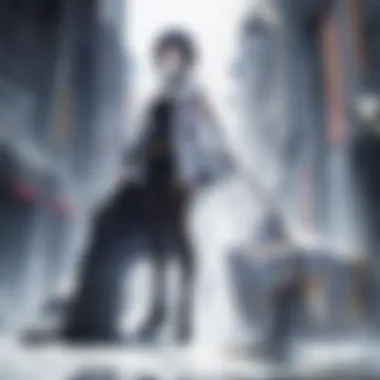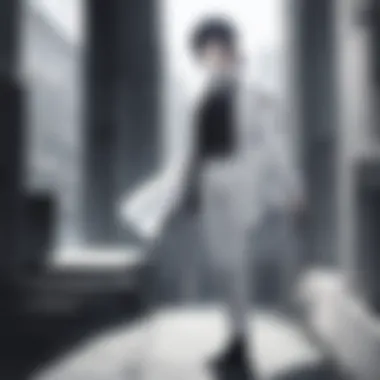In-Depth Analysis of Code Breaker Anime: Themes and Characters


Prelims to the Series
'Code Breaker' immerses audiences in a realm where justice intertwines with the supernatural. This action-packed anime adaptation stems from the manga written and illustrated by Akimine Kamijyo. The genre encapsulates shounen themes, blending drama and fantasy with ethical dilemmas as central nodes in its narrative.
First released as a manga in 2008, it transitioned into an anime format in 2012, capturing the interest of many fans. The series introduces viewers to characters who manipulate flames, exploring how they confront societal issues. Despite a challenging plot, the show cultivates suspense and curiosity, prompting viewers to ponder moral complexities.
The popularity of 'Code Breaker' can be attributed to its unique storyline, paired with the striking designed visuals that coincide with its anime style. Fans of supernatural tales found it particularly appealing, while the connections to broader societal themes elevated its standing within the anime community.
Staff and Cast Details
Understanding the minds behind the creation enriches the viewing experience. Directed by Yūji Kumazawa, he guided the production team effectively, ensuring the essence of the manga remained intact. Colaborating with notable scriptwriter Masahiro Yokotani, character designs were crafted by Takahiro Yoshimatsu, adding depth to the personas.
The voice cast brought life to the characters, enhancing their narratives. Some key performers include:
- Kazuya Nakai as the fierce and powerful protagonist, showing a diverse range of emotions.
- Jun Fukuyama, who added complexity to his character, reflecting nuanced expressions.
- Mikako Komatsu, who portrayed significant supporting roles effectively.
The synergy between the cast’s acting and direction cultivated an immersive experience, engaging audiences in the struggles of each character.
Theme Music Analysis
The series employs distinct opening and ending themes that resonate with its themes. The opening theme,
Prelude to Code Breaker Anime
The realm of anime is vast, with thematic diversity and narrative depth. Code Breaker anime stands out for its intricate storytelling and complex characters. This series has captured the attention of both casual viewers and avid fans. In crafting a comprehensive analysis of Code Breaker, one must first address its foundational elements. Understanding the introductory aspects provides context. This series merges elements of action and moral questioning, setting it apart in the crowded anime landscape.
Overview of the Series
Code Breaker revolves around a unique premise that intertwines justice and ethics. The story follows Sakura Sakurakoji, a high school student, and Ogami Rei, a virtual vigilante known as Code Breaker. Both characters engage in a constant battle against societal wrongs, questioning the conventional ideas of right and wrong. This anime masterfully blends emotional depth with action, drawing viewers into its multi-faceted narratives. The characters' motivations compel audiences to engage with the story on a more personal level, making Code Breaker an example of well-executed character development within its genre.
Premise and Setting
The setting of Code Breaker is critical to understanding its narrative. The city, which reflects a blend of contemporary life with elements of fantasy, serves as a canvas for the intense struggles of its characters. Speficially, it's a place where Ogami, a Code Breaker, exercises his powers to eliminate those he considers evil. The backdrop complements the anime's themes of moral ambiguity. The clashes between characters are not merely physical but also philosophical. This juxtaposition allows viewers to ponder the boundaries of justice and the costs associated with it. The popularity of the anime often invites comparisons with other their similar works, inviting discussions and analysis among anime fans worldwide, fostering a community of critique and appreciation.
"Anime often serves as a reflection of society. Code Breaker challenges viewers to rethink their perceptions of justice."
Main Characters and Their Development
Main characters serve as the drivers of any narrative, shaping not just the story but also its emotional resonance. In the context of Code Breaker anime, the principal characters—Sakura and Ogami—embody deeply defined journeys that invite analysis and appreciation. Their roles are integral to understanding the series. Each character represents differing perspectives on central themes, providing viewers with points of connection and reflection. Analyzing character development contributes significantly to fully grasping the anime's narrative deeper.
Protagonists: Defining Traits
Code Breaker Sakura
Code Breaker Sakura emerges as a compelling character whose development significantly enhances the thematic depth of Code Breaker. An important aspect of Sakura is her steadfast sense of justice. This trait drives her actions and influences her encounters with Ogami and other characters. Sakura’s vision often contrasts with Ogami’s methods, which leads to interesting dilemmas throughout the series.
One key characteristic of her is resilience. Despite facing harsh realities and struggles, she maintains a firm resolve, which resonates with many viewers. This resilience serves as an encouraging narrative device in an anime that explores serious themes like morality and justice. Sakura's unique feature of inherent empathy towards the troubled highlights her internal conflict vividly.
Setbacks serve dual purposes for her character. While they showcase vulnerability, they also offer opportunities for growth. As she confronts challenges, viewers witness evolution—an arc that adds richness to the story, making her a relatable figure.
Code Breaker Ogami
Code Breaker Ogami stands out with his complex identity as both an anti-hero and protector. His contributions help define the darker elements inherent in the series’ narrative. Ogami’s characterization is heavily influenced by his stark view on justice, which often places him on a moral perimeter not shared by others. This aspect intrigues audiences, providing a lens through which to question societal norms and laws.


One significant characteristic of Ogami is his determinism in applying force to achieve outcomes. This approach creates tension, particularly contrasting with Sakura's methods. This clash develops as a pivotal narrative tool that invites constant comparisons of justice beliefs within the idea of vigilantism.
Ogami's unique feature is his subdued ability to influence—his quiet resolve draws others towards him. Often, allies’ growth stems from interactions with him, underscoring his importance within the narrative. The mix of isolationism and connection defines Ogami’s journey, compellingly illustrating the moral gray areas within the storyline.
Supporting Characters
Supporting characters in Code Breaker are strategically essential, enriching the narrative arcs and adding layers to central themes. By analyzing Character Dynamics and the Role in the Narrative, we uncover how these individuals mold the plot and character enhancements.
Character Dynamics
The interplays among supporting characters produce significant dynamics that contribute to saga evolution. These characters are not merely background; instead, they have unique traits that influence major players. Their interactions provide tension and foster decisions that propel developments. One remarkable aspect is how each character embodies traits that reflect or counterbalance qualities from our protagonists.
A strong highlighting characteristic of various supporting characters is loyalty, which creates pathways for intricate relational structures. Such connections establish loyalty bonds that are key in addressing central conflicts. This weaving signifies a rich tapestry of relationships, benefiting narrative trajectory through necessity found in collaboration and individual sacrifice.
Role in the Narrative
The role these supporting characters play cannot be underestimated. Their contributions vary widely—some present opposing forces, while others help solidify protagonists' objectives. Beyond mere participation, they offer fresh directions for plotlines that challenge and inspire our main characters.
One notable characteristic in examining their role is significant plot advancement. Their stories intertwine with the journey of Sakura and Ogami directly. In doing so, we get deeper insights into the narrative complexities involved.
By delving into these aspects, Code Breaker, thus, unveils a well-rounded exploration of humanity's struggle with moral dilemmas and justice. Characters begin to serve their roles meaning past just functioning; their dynamics change viewer perceptions. Each character can represent different viewpoints and struggles viewers indirectly may face in their moral quests.
Narrative Structure and Themes
Understanding the narrative structure and themes in "Code Breaker" is crucial to appreciate its depth and relevance in the anime landscape. This section outlines how the way stories are told can enhance viewer engagement and generate critical discussions. Each episode and arc contributes to an overarching storyline that challenges personal and societal values.
Plot Progression
The plot of "Code Breaker" unfolds in a manner that is both dynamic and layered. The progression is not linear; instead, it features intertwining story arcs. This complexity enables characters to develop more robustly and gives the audience a reason to remain invested in the outcome.
Events often interconnect to build tension and maintain an engaging rhythm. Flashbacks and character backstories are used effectively, providing context that informs the present narrative. Such a structure accomplishes several objectives:
- It enhances character understanding, offering insight into their motivations.
- Amplifies emotional stakes by weaving history into confrontation scenes.
- This distinction fosters analytical thinking in viewers, inviting them to decipher characters' choices against their past.
By connecting past decisions with present actions, the narrative structure offers a richer experience.
Key Themes Explored
Themes in any narrative serve not only to entertain but also to provoke thought. "Code Breaker" navigates complex terrains, especially focusing on concepts such as justice and morality.
Justice vs.
Vigilantism
The theme of justice versus vigilantism forms a significant pillar. This dichotomy appeals to the audience's natural curiosity regarding moral righteousness.
On one hand, justice is characterized by formalized systems governing society. On the other hand, vigilantism represents individual action against perceived wrongs. In "Code Breaker," the protagonists wrestle with their understanding of both concepts. This tension leads to various conflicts, making it not only a beneficial theme but also a focal point of many pivotal scenes.
Highlights of this theme include:
- Authenticity: Characters' motivations reflect a spectrum of ethical dilemmas.
- Relatability: The struggle between conforming to law and personal beliefs resonates with viewers.
- Engaging discussions arise on broader societal implications.
Such exploration of justice drives the narrative forward and stimulates dialogue among fans.
Moral Ambiguity


The exploration of moral ambiguity adds another layer of complexity. It challenges the clear-cut black-and-white narratives often found in other series. Characters face dilemmas that do not have an easy resolution, promoting the idea that morality is often nuanced.
This theme stands out for several reasons:
- Complex Characters: They often embody virtues and flaws, creating a balance that feels genuine.
- Dynamic Plot Points: As characters confront morally grey situations, their responses can take unpredictable directions.
Moral ambiguity in heightens engagement, diverging from typical tropes. It encourages audiences to consider the consequences of their choices identifying with characters playing dual roles of hero and antagonist.
Thereby, the narrative structure in
Production Insights
Understanding the production insights of 'Code Breaker' is crucial to grasp the animation's artistry and the ideas fuelling its narrative. These insights shed light on the creatives that contributed to bringing this anime to life, outlining their methodologies, choices, and influences. Knowledge of the studio behind the project and the staff’s contributions allows fans and scholars alike to appreciate the depth and labor involved in the animation creation process. Moreover, exploring the production elements can reveal the themes that are prevalent within the series, as well as the technical innovations that may enhance the viewing experience.
Studio and Staff
'Code Breaker' was produced by Kinema Citrus, a studio known for its impressive resume that includes other notable titles. This studio brought a unique vision to the series, leveraging its experienced staff that specializes in anime production. The team's familiarity with adaptating source material, combined with their knowledge of storytelling essentials, played a vital role in the anime's execution.
The core staff included:
- Director: The individuals ushered the narrative into a well-paced adventure, crucially shaping the viewing experience. Their interpretive skills allowed them to translate complex narratives from manga format into engaging screenplays suited for anime.
- Writer: With an ability to capture the essence of characters in dialogue and action sequences, they significantly impacted character development.
- Character Designer: The artist's distinctive art style confused had a lasting impact on viewers’ perceptions of the characters. Enhancing the visual personality connected well with the audience.
These combined efforts produced a coherent work where storytelling and visuals resonated with fans leading to a successful series, which achieved notable acclaim in the anime community.
Art Style and Animation Techniques
The formal aspects of art style and animation techniques are integral in understanding what makes 'Code Breaker' distinctive. The approach taken by the animators can set a tone that amplifies it’s plot and character arcs greatly.
The character designs are sharp and expressive, emphasizing features that reflect their personalities. They possess stylistic appeal with clean lines and dynamic proportions. This style stands out in action sequences where agility and strength among characters come through vividly.
- The fighting choreography consists of fluid motions that have meticulously planned to highlight the skills of Code Breaker Ogami and others.
- Backgrounds displaysare detailed artistically to emphasize focus on the characters’ interactions.
- Excellent use of color contrasts enhance key moments, evoking emotional responses from the audience.
Animation techniques used include:
- Cel Animation: A traditional yet effective approach in capturing movement and emotion.
- CGI Integration: For some action scenes, they equipped CGI strategically while maintaining the integrity of hand-drawn elements.
The combination of these elements speaks to the careful consideration given towards weaving the anime's visual aesthetic with its narrative flow, resulting in a work that elevates the original material's impact.
Music and Sound Design
The music and sound design in Code Breaker anime plays a pivotal role in shaping the overall atmosphere and emotional depth of the series. Through a well-crafted soundscape, it engages viewers on multiple levels and enhances character development. Aspects such as opening and ending themes, along with background scores and sound effects, contribute significantly to the show’s impact.
Opening and Ending Themes
The opening and ending themes of Code Breaker serve as emotional bookends for each episode. These themes are not only catchy but also encapsulate the essence of the series. The opening theme often introduces the viewers to the fraught world of vigilante justice and moral dilemmas. Conversely, the ending theme provides a moment of reflection, allowing for emotional processing after intense scenes.
- Strings and Vocals: The integration of string instruments in the opening gives a sense of urgency, while vocals express the inner turmoil of the characters.
- Lyrical Content: Lyrics often tap into the themes of justice, sacrifice, and emotional struggle, resonating deeply with the audience.
- Varying Genres: Different genres explored in these themes keep auditory experience fresh, catering to diverse listener tastes.
These pieces operate on multiple levels—from narrative reinforcement to emotional connectivity.
Background Score and Sound Effects
The background score in Code Breaker meticulously complements the plot and enhances much of the story's tension and pathos. Sound effects also play an crucial role in immersing the viewer in action and drama.
- Dynamic Layering: The background score is skillfully layered to match the pacing of scenes, using faster tempos during fight scenes, while embracing slower, more melancholic tones during moments of introspection.
- Instrument Selection: Various instruments, from percussions to electronic elements, are employed to emphasize the unique settings and emotional states character go through.
- Realism through Sound Effects: Sound design includes small but essential detail, like the rustling of clothing or ambient city noise, all working together to create an engaging world that reflects the series’ darker, morally ambiguous themes.


The combined effect of the music and sound design not only propels the narrative but also fosters a deep emotional connection with the audience.
Through these elements of music and sound, the execution and depth of Code Breaker anime is amplified, providing an immersive experience that keeps audiences invested.
Cultural Impact and Reception
Cultural impact and reception are crucial in understanding the significance of anime series like 'Code Breaker.' They reflect not only how the audience perceives the series but also its larger relevance in popular culture. 'Code Breaker' blends unique storytelling with character depths, creating an emotionally resonant experience that speaks to themes like justice and morality. Through its narrative and artistic choices, it ultimately shapes fan discussions, academic critiques, and wider industry trends.
Critical Acclaim and Reviews
Upon its release, 'Code Breaker' garnered notable acclaim from critics and fans alike. Many praised the series for its adventurous plot and thought-provoking themes. Reviewers often highlighted the pacing as a strength, enabling a thrilling viewing experience without losing character development.
Some of the reviews compare its approach to vigilance with other anime in the genre. Critics noted how it encourages debates about personal beliefs regarding justice and societal role in enforcing it.
"One of the striking elements of 'Code Breaker' is its candid exploration of moral dilemmas in a captivating format."
These conversations are key to understanding the anime's impact. Critics from major platforms like MyAnimeList and Crunchyroll stated that the artistry and animation add to the layered storytelling. High scores frequently reflect a well-rounded presentation, including action sequences blended with serious narratives. The consistency in plot momentum, while addressing rich themes, is epic and engaging for audiences.
Fan Reception and Community Engagement
The fandom surrounding 'Code Breaker' is vibrant and active. Since its debut, fans have built communities discussing various facets of the show, like character arcs, moral conflicts, and personal interpretations of justice. Platforms such as Reddit and specialized forums feature detailed analyses and lively discussions regarding plot theories. Fans often share fan art, character explorations, and thematic discussions, which emphasize the series' emotional resonance.
Social media engagement also plays a significant role. Dedicated hashtags help fans connect over shared interests and express their opinions on episodes as they air. There’s a noticeable enthusiasm in creating and sharing memes, fan edits, and review discussions that enrich the overall experience of engaging with the series.
Furthermore, conventions focusing on anime culture often feature panels discussing 'Code Breaker.' These are excellent spaces for fans to voice their thoughts on characters, storylines, and broader themes. Community engagement ranges from casual conversations to formal documentation of critical perspectives.
Comparative Analysis
The comparative analysis section plays a crucial role in understanding both the uniqueness and similarities of Code Breaker anime within the broader context of similar works. Analyzing various series allows for a clearer appreciation of the thematic depth, character development, and narrative structure presented in Code Breaker. Moreover, it helps audiences identify what sets this anime apart or what it shares with others, enhancing their viewing experience.
This dialogue invites a deep exploration of how Code Breaker engages with recurring themes, enables comparisons with notable works like Death Note or Akame ga Kill, and reveals how distinct storytelling techniques influence audience reception. By examining these connections, viewers can grasp the intricate mechanics at play in Code Breaker, facilitating a nuanced comprehension that extends beyond surface-level engagement.
Similar Themes in Other Anime
The thematic exploration of justice, moral ambiguity, and the role of heroes are central in many anime. Code Breaker stands shoulder to shoulder with notable series that grapple with questions about right and wrong.
- Death Note: Both series probe into the psychology of vigilante justice. Light Yagami's obsession with his role as a judge mirrors Ogami’s pursuit of justice, creating tension between their moral choices.
- Akame ga Kill: In this series, characters also grapple with the consequences of their choices while taking extreme measures to achieve their goals. Just like Code Breaker, the motivations and subsequent actions of individuals are starkly portrayed.
- My Hero Academia: This series offers a different perspective on heroism. Though it presents a more traditional hero narrative, critical inquiries into ethical dilemmas appear in character arcs and storylines similar to Code Breaker.
When these anime are compared side-by-side, we notice recurring narrative patterns. They model stark realities of righteousness, often challenging audiences to confront their own views on morality and justice.
Contrasts with Other Series
While Code Breaker relates well to certain narratives, it also presents defining contrasts that illustrate its unique place in anime culture.
- Art Style: Many series might employ saturated colors to enhance lively action scenes. However, Code Breaker adopts a more subdued palette which reflects the series' darker tone and moral incongruities.
- Character Motivations: Unlike Naruto, where characters primarily aim for growth and camaraderie, characters in Code Breaker are frequently isolated in their experiences, often burdened by their own choices. This adds layers to their development and shifts the typical characteristics expected from protagonists.
- Narrative Tone: Serial narratives such as One Piece focus heavily on adventure and comic elements while Code Breaker is grounded in a more serious narrative form. This serves to heighten suspense and drama, emphasizing consequences and intrinsic struggles.
Epilogue
The conclusion of our analysis on the "Code Breaker" anime serves as an integral segment, consolidating the diverse elements discussed throughout the article. This final section encapsulates the essence of the series, allowing readers to reflect on its narrative intricacies, character complexities, and cultural significance. A strong conclusion offers valuable insights, reiterating the themes and thought-provoking questions that permeate the series.
Final Thoughts on Code Breaker
In essence, "Code Breaker" exemplifies the battle between moral absolutes and nuanced beliefs. The show's intricate character arcs, especially that of Sakura and Ogami, engage viewers. It pushes boundaries regarding societal norms and values. By blending shounen elements with deeper philosophical inquiries, the anime carves a niche for itself within the crowded anime landscape. Fans appreciate its refreshing take on familiar tropes and the emotional connections found throughout the journey of its characters.
Future of the Series
The future of "Code Breaker" appears intertwined with continual interest from its audience. Animated adaptations often experience varying trajectories after their initial run; yet, the source manga's ongoing popularity suggests potential for revival or continuation in new forms.
Engaging the fan base through social media platforms can be key. Conversations around sequels or adaptations foster community spirit. As long as dedicated enthusiasts share their love for the series's balance of action with moral dilemas, there always remains a beacon of possibility for its return. Hence, one can hope for a continued exploration of themes beyond the original arc, centering on character growth, and the wider implications of justice and retribution.
Understanding the impact of complex characters and narratives, like those in 'Code Breaker,' helps shape our engagement with future anime.















